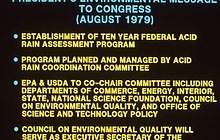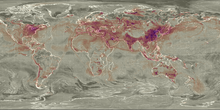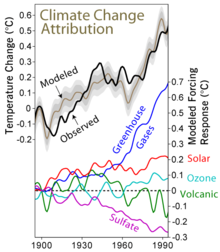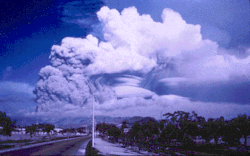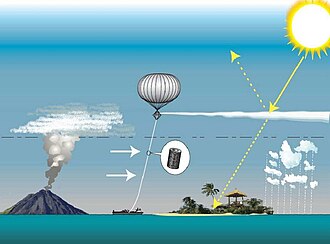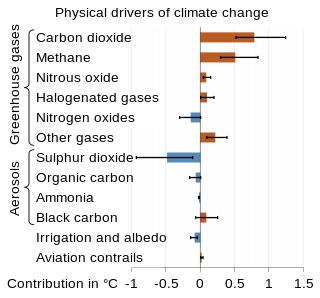
The scientific community has been investigating the causes of climate change for decades. After thousands of studies, it came to a consensus, where it is "unequivocal that human influence has warmed the atmosphere, ocean and land since pre-industrial times." This consensus is supported by around 200 scientific organizations worldwide, The dominant role in this climate change has been played by the direct emissions of carbon dioxide from the burning of fossil fuels. Indirect CO2 emissions from land use change, and the emissions of methane, nitrous oxide and other greenhouse gases play major supporting roles.

Nuclear winter is a severe and prolonged global climatic cooling effect that is hypothesized to occur after widespread firestorms following a large-scale nuclear war. The hypothesis is based on the fact that such fires can inject soot into the stratosphere, where it can block some direct sunlight from reaching the surface of the Earth. It is speculated that the resulting cooling would lead to widespread crop failure and famine. When developing computer models of nuclear-winter scenarios, researchers use the conventional bombing of Hamburg, and the Hiroshima firestorm in World War II as example cases where soot might have been injected into the stratosphere, alongside modern observations of natural, large-area wildfire-firestorms.
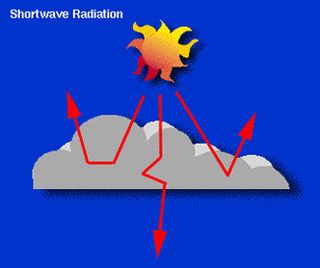
Cloud feedback is a type of climate change feedback, where the overall cloud frequency, height, and the relative fraction of the different types of clouds are altered due to climate change, and these changes then affect the Earth's energy balance. On their own, clouds are already an important part of the climate system, as they consist of water vapor, which acts as a greenhouse gas and so contributes to warming; at the same time, they are bright and reflective of the Sun, which causes cooling. Clouds at low altitudes have a stronger cooling effect, and those at high altitudes have a stronger warming effect. Altogether, clouds make the Earth cooler than it would have been without them.

Sulfur dioxide or sulphur dioxide is the chemical compound with the formula SO
2. It is a toxic gas responsible for the odor of burnt matches. It is released naturally by volcanic activity and is produced as a by-product of copper extraction and the burning of sulfur-bearing fossil fuels. It was known to alchemists as "volatile spirit of sulfur" since at least 16th century.

The sulfate or sulphate ion is a polyatomic anion with the empirical formula SO2−4. Salts, acid derivatives, and peroxides of sulfate are widely used in industry. Sulfates occur widely in everyday life. Sulfates are salts of sulfuric acid and many are prepared from that acid.

A volcanic winter is a reduction in global temperatures caused by droplets of sulfuric acid obscuring the Sun and raising Earth's albedo (increasing the reflection of solar radiation) after a large, sulfur-rich, particularly explosive volcanic eruption. Climate effects are primarily dependent upon the amount of injection of SO2 and H2S into the stratosphere where they react with OH and H2O to form H2SO4 on a timescale of a week, and the resulting H2SO4 aerosols produce the dominant radiative effect. Volcanic stratospheric aerosols cool the surface by reflecting solar radiation and warm the stratosphere by absorbing terrestrial radiation for several years. Moreover, the cooling trend can be further extended by atmosphere–ice–ocean feedback mechanisms. These feedbacks can continue to maintain the cool climate long after the volcanic aerosols have dissipated.

Global dimming is a decline in the amount of sunlight reaching the Earth's surface. It is caused by atmospheric particulate matter, predominantly sulfate aerosols, which are components of air pollution. Global dimming was observed soon after the first systematic measurements of solar irradiance began in the 1950s. This weakening of visible sunlight proceeded at the rate of 4–5% per decade until the 1980s. During these years, air pollution increased due to post-war industrialization. Solar activity did not vary more than the usual during this period.
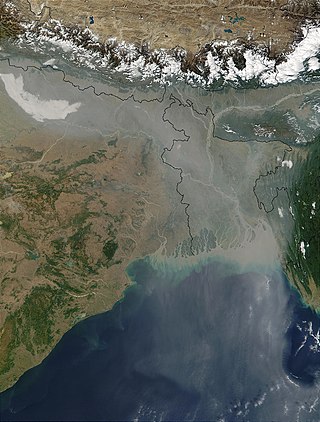
Cloud condensation nuclei (CCNs), also known as cloud seeds, are small particles typically 0.2 μm, or one hundredth the size of a cloud droplet. CCNs are a unique subset of aerosols in the atmosphere on which water vapour condenses. This can affect the radiative properties of clouds and the overall atmosphere. Water vapour requires a non-gaseous surface to make the transition to a liquid; this process is called condensation.
Climate engineering is an umbrella term for both carbon dioxide removal and solar radiation modification, when applied at a planetary scale. However, these two processes have very different characteristics. For this reason, the Intergovernmental Panel on Climate Change no longer uses this overarching term. Carbon dioxide removal approaches are part of climate change mitigation. Solar radiation modification is reflecting some sunlight back to space. All forms of climate engineering cannot be standalone solutions to climate change, but need to be coupled with other forms of climate change mitigation. Some publications place passive radiative cooling into the climate engineering category. This technology increases the Earth's thermal emittance. The media tends to use climate engineering also for other technologies such as glacier stabilization, ocean liming, and iron fertilization of oceans. The latter would modify carbon sequestration processes that take place in oceans.

Paul Jozef Crutzen was a Dutch meteorologist and atmospheric chemist. He and Mario Molina and Frank Sherwood Rowland were awarded the Nobel Prize in Chemistry in 1995 for their work on atmospheric chemistry and specifically for his efforts in studying the formation and decomposition of atmospheric ozone. In addition to studying the ozone layer and climate change, he popularized the term Anthropocene to describe a proposed new epoch in the Quaternary period when human actions have a drastic effect on the Earth. He was also amongst the first few scientists to introduce the idea of a nuclear winter to describe the potential climatic effects stemming from large-scale atmospheric pollution including smoke from forest fires, industrial exhausts, and other sources like oil fires.
This is a list of climate change topics.

Solar radiation modification (SRM), or solar geoengineering, is a type of climate engineering in which sunlight would be reflected back to outer space to offset human-caused climate change. There are multiple potential approaches, with stratospheric aerosol injection being the most-studied, followed by marine cloud brightening. SRM could be a temporary measure to limit climate-change impacts while greenhouse gas emissions are reduced and carbon dioxide is removed but would not be a substitute for reducing emissions.

Arctic geoengineering is a type of climate engineering in which polar climate systems are intentionally manipulated to reduce the undesired impacts of climate change. As a proposed solution to climate change, arctic geoengineering is relatively new and has not been implemented on a large scale. It is based on the principle that Arctic albedo plays a significant role in regulating the Earth's temperature and that there are large-scale engineering solutions that can help maintain Earth's hemispheric albedo. According to researchers, projections of sea ice loss, when adjusted to account for recent rapid Arctic shrinkage, indicate that the Arctic will likely be free of summer sea ice sometime between 2059 and 2078. Advocates for Arctic geoengineering believe that climate engineering methods can be used to prevent this from happening.

Marine cloud brightening also known as marine cloud seeding and marine cloud engineering is a proposed solar radiation management climate engineering technique that would make clouds brighter, reflecting a small fraction of incoming sunlight back into space in order to offset anthropogenic global warming. Along with stratospheric aerosol injection, it is one of the two solar radiation management methods that may most feasibly have a substantial climate impact. The intention is that increasing the Earth's albedo, in combination with greenhouse gas emissions reduction, carbon dioxide removal, and adaptation, would reduce climate change and its risks to people and the environment. If implemented, the cooling effect is expected to be felt rapidly and to be reversible on fairly short time scales. However, technical barriers remain to large-scale marine cloud brightening. There are also risks with such modification of complex climate systems.
David W. Keith is a professor in the Department of the Geophysical Sciences at the University of Chicago. He joined the University of Chicago in April 2023. Keith previously served as the Gordon McKay Professor of Applied Physics for Harvard University's Paulson School of Engineering and Applied Sciences (SEAS) and professor of public policy for the Harvard Kennedy School at Harvard University. Early contributions include development of the first atom interferometer and a Fourier-transform spectrometer used by NASA to measure atmospheric temperature and radiation transfer from space.

Particulates or atmospheric particulate matter are microscopic particles of solid or liquid matter suspended in the air. The term aerosol commonly refers to the particulate/air mixture, as opposed to the particulate matter alone. Sources of particulate matter can be natural or anthropogenic. They have impacts on climate and precipitation that adversely affect human health, in ways additional to direct inhalation.
Tectonic–climatic interaction is the interrelationship between tectonic processes and the climate system. The tectonic processes in question include orogenesis, volcanism, and erosion, while relevant climatic processes include atmospheric circulation, orographic lift, monsoon circulation and the rain shadow effect. As the geological record of past climate changes over millions of years is sparse and poorly resolved, many questions remain unresolved regarding the nature of tectonic-climate interaction, although it is an area of active research by geologists and palaeoclimatologists.

Nadine Unger is a Professor of Atmospheric Chemistry at the University of Exeter. She has studied the role of human activities and forests on the Earth's climate.
Georgiy L. Stenchikov is an applied mathematician and climate scientist focusing on studies of physical processes that govern the Earth's climate. He is a professor in the Department of Earth Science and Engineering at the King Abdullah University of Science and Technology in Saudi Arabia.



